
The Kingdom of Thessalonica was a short-lived Crusader State founded after the Fourth Crusade over conquered Byzantine lands in Macedonia and Thessaly.
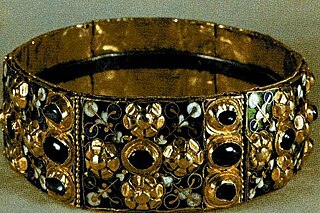
King of Italy was the title given to the ruler of the Kingdom of Italy after the fall of the Western Roman Empire. The first to take the title was Odoacer, a "barbarian" military leader, in the late 5th century, followed by the Ostrogothic kings up to the mid-6th century. With the Frankish conquest of Italy in the 8th century, the Carolingians assumed the title, which was maintained by subsequent Holy Roman Emperors throughout the Middle Ages. The last Emperor to claim the title was Charles V in the 16th century. During this period, the holders of the title were crowned with the Iron Crown of Lombardy.

The Duchy of Milan was a state of the Holy Roman Empire in northern Italy. It was created in 1395, when it included twenty-six towns and the wide rural area of the middle Padan Plain east of the hills of Montferrat. During much of its existence, it was wedged between Savoy to the west, Venice to the east, the Swiss Confederacy to the north, and separated from the Mediterranean by Genoa to the south. The Duchy eventually fell to Habsburg Austria with the Treaty of Baden (1714), concluding the War of the Spanish Succession. The Duchy remained an Austrian possession until 1796, when a French army under Napoleon Bonaparte conquered it, and it ceased to exist a year later as a result of the Treaty of Campo Formio, when Austria ceded it to the new Cisalpine Republic.
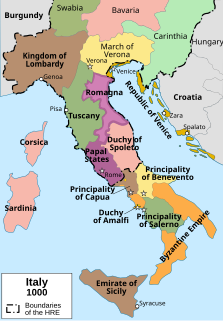
The Duchy of Spoleto was a Lombard territory founded about 570 in central Italy by the Lombard dux Faroald. Its capital was the city of Spoleto.

Saint Galdino della Sala, or Saint Galdinus, was a Roman Catholic saint from Milan in northern Italy. He was a cardinal elevated in 1165 and he also served as Archbishop of Milan from 1166 to his death in 1176. He was a staunch supporter both of Pope Alexander III, and of Milan and its neighbours in Lombardy, in their joint and parallel struggles against the Antipope Victor IV, supported by Holy Roman Emperor Frederick I Barbarossa.
William V of Montferrat also known regnally as William III of Montferrat while also referred to as William the Old or William the Elder, in order to distinguish him from his eldest son, William Longsword, was seventh Marquess of Montferrat from c. 1136 to his death in 1191. William was the only son of marquess Renier I and his wife Gisela, a daughter of William I, Count of Burgundy and widow of Count Humbert II of Savoy. It seems likely, given that he was still fit enough to participate in battle in 1187, that William was one of his parents' youngest children.

Arduin was an Italian nobleman who was Margrave of Ivrea and King of Italy (1002–1014).
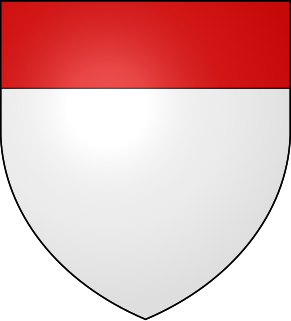
Demetrius or Demetrios of Montferrat, , was king of Thessalonica from 1207 to 1224.

The Kingdom of Italy was one of the constituent kingdoms of the Holy Roman Empire, along with the kingdoms of Germany, Bohemia, and Burgundy. It comprised northern and central Italy, but excluded the Republic of Venice and the Papal States. Its original capital was Pavia until the 11th century.

The (Princely) County of Tyrol was an estate of the Holy Roman Empire established about 1140. Originally a jurisdiction under the sovereignty of the Counts of Tyrol, it was inherited by the Counts of Gorizia in 1253 and finally fell to the Austrian House of Habsburg in 1363. In 1804 the Princely County of Tyrol, unified with the secularised Prince-Bishoprics of Trent and Brixen, became a crown land of the Austrian Empire in 1804 and from 1867 a Cisleithanian crown land of Austria-Hungary.

Chiavenna is a comune (municipality) in the Province of Sondrio in the Italian region of Lombardy. It is the centre of the Alpine Valchiavenna region. The historic town is a member of the Cittaslow movement.

Gravellona Lomellina is a comune (municipality) in the Province of Pavia in the Italian region Lombardy, located about 35 km southwest of Milan and about 35 km northwest of Pavia. It's an agricultural town.

Anselm IV was the Archbishop of Milan from 3 November 1097 to his death on 30 September 1101. He was a close friend of Pope Urban II and prominent in the Crusade of 1101, whose Lombard contingent he led and on which he died.
Guy or Guido Pallavicini, called Marchesopoulo by his Greek subjects, was the first marquess of Bodonitsa in Frankish Greece from 1204 to his death in or shortly after 1237. He was one of the most important Frankish rulers in Greece, and played a major role in the short-lived Kingdom of Thessalonica: in 1208–1209 he supported the Lombard rebellion against King Demetrius of Montferrat, but by 1221 he was the kingdom's regent (bailli), and was left to defend the city against the ruler of Epirus, Theodore Komnenos Doukas. Left unsupported by the Latin Empire, and with a projected crusade to relieve the city delayed, he surrendered the city in December 1224. The belated arrival of the crusade helped to save his own fief from falling to the Epirotes, however, and he was soon able to return there, dying on or shortly after 1237.

The March of Tuscany was a frontier march of the Kingdom of Italy and the Holy Roman Empire during the Middle Ages.
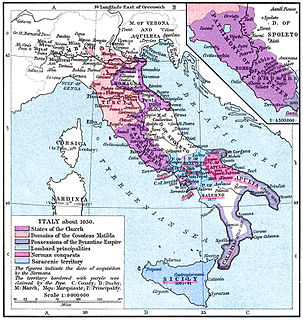
The March of Verona and Aquileia was a vast march of the Holy Roman Empire in northeastern Italy during the Middle Ages, centered on the cities of Verona and Aquileia. Seized by King Otto I of Germany in 952, it was held by the Dukes of Bavaria; from 976 in personal union with the Duchy of Carinthia. The margravial regime ended with the advent of the Lombard League in 1167.
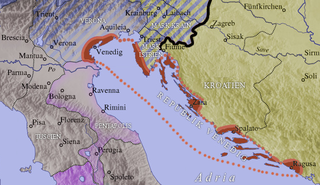
The March of Istria was originally a Carolingian frontier march covering the Istrian peninsula and surrounding territory conquered by Charlemagne's son Pepin of Italy in 789. After 1364, it was the name of the Istrian province of the Habsburg Monarchy, the Austrian Empire and Austria-Hungary.

The Della Torre were an Italian noble family who rose to prominence in Lombardy during the 12th-14th centuries, until they held the lordship of Milan before being ousted by the Visconti.
The Abbey of the Saints Nazario and Celso, located in the municipality of San Nazzaro Sesia Sesia, is one of the most significant monastic complexes in Piedmont: it consists of a city wall with circular corner towers, a high Romanesque bell tower, a church in Lombard Gothic style and an elegant cloister with a group of 15th-century frescoes dedicated to the stories of St. Benedict.



























